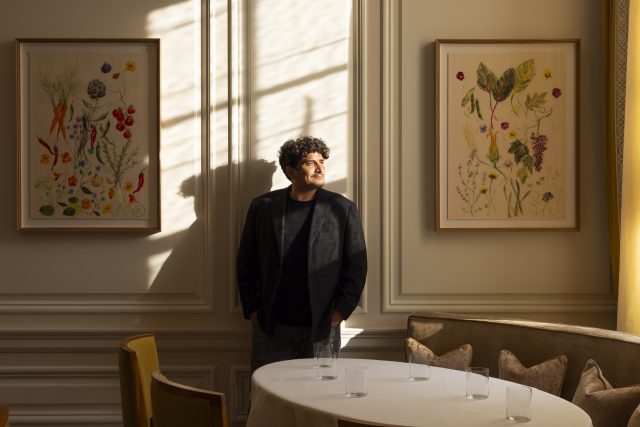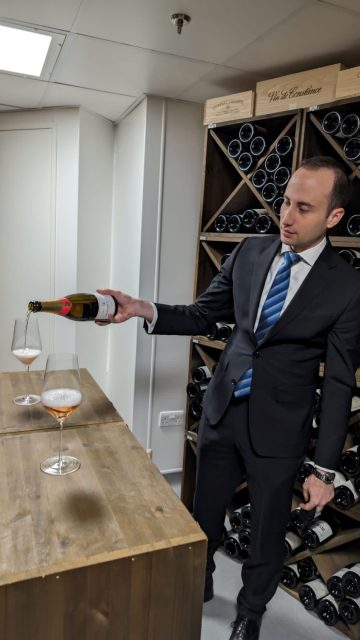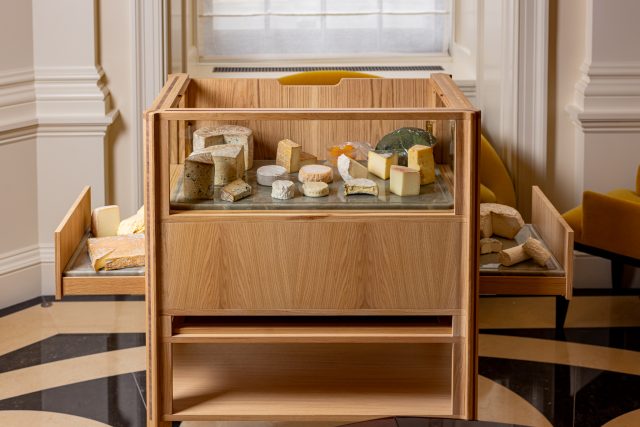This website uses cookies so that we can provide you with the best user experience possible. Cookie information is stored in your browser and performs functions such as recognising you when you return to our website and helping our team to understand which sections of the website you find most interesting and useful.
db Eats: Mauro Colagreco at Raffles at The OWO
Douglas Blyde visits Mauro Colagreco’s newly-opened restaurant at Raffles at The OWO (Old War Office). Fittingly opening with a glass of Pol Roger’s Cuvée Sir Winston Churchill, he delves into how the extensive list “celebrates the British contribution to the world of wine”.

“The Hinduja Group’s £1.4 billion overhaul of the Grade II-listed Old War Office in Whitehall is perhaps the splashiest hospitality launch of an unusually splashy autumn,” wrote Evening Standard’s Jimi Famurewa of the “municipal palazzo of buffed marble columns, subterranean bars and no fewer than nine new places to eat and drink…” Of these, “the fanciest option” is Mauro, according to Catherine Hanly of Hot Dinners, with its “super slick” service and plentiful “theatrical flourishes”. Overseeing operational aspects at the property when it comes to comestibles is the director of food and beverage, and restaurant fanatic, Mark Hastings, formerly of Jason Atherton’s Social Company, Mandarin Oriental Park Lane, and Hakkasan Group.
Design
Andrea Bocelli and Andrew Lloyd Webber serenaded guests at the pre-launch of what is the first Raffles in the UK, spanning a mighty building which had hitherto been off limits to civilians since the reign of King Edward VII.
“This is not a normal hotel” said the spirited Fiona Harris, former director of PR for Corinthia Hotels, turned head of VIP relations for Selfridges, and now Communications Director at this endeavour, as we begin the tour at “what is becoming the world’s most photographed staircase” replete with its “After Eight-style clock.” Comprising 26,000 tons of Portland stone, 3,000 tons of York stone, 19,000 feet of ornamental cast iron grilles, 18,000 square yards of Roman cube mosaic and terrazzo, 17 miles of plaster cornices, and 25 million “ordinary bricks”, the trapezium shaped fortress, equipped with a doublet of moats and seven feet thick walls, originally took seven years to build, “but eight years” to overhaul. It first brought together 2,300 government and military officials over 1,000 rooms linked by 2.5 miles of ten-foot-wide corridors threaded with telephony cables. Down these “messenger boys on bikes” dashed.
It remained under the tenure of the British Army until 2014. Now under a long lease to the Hinduja Group, excavations were made for a four-level spa including a 25-metre pool, and a ballroom which seats 600 served by a dedicated car lift. Just 120 bedrooms, of which 39 are suites, take in the former offices of storied politicos and military leaders, supplemented by a further 85 Raffles-branded residences in another wing. Neighbouring hotels, one of which was requisitioned from the Ministry of Defence in 2007, might well feel an inferiority complex…
Drinks
Vincenzo Arnese is the sharp-suited director of wine. A Star Wars fan, Arnese, who rates Yoda’s saying, “Do or do not, there is no try”, formerly worked at a hat trick of three Michelin-starred restaurants, being Alain Ducasse at The Dorchester where he was head sommelier – and Monsieur Ducasse has already visited him here, The Fat Duck, albeit for a week on reconnaissance, and The Waterside Inn, as well as Dinner by Heston Blumenthal, and in Australia, the aptly named Vue de Monde on the 55th floor of the Rialto building. His love for wine was sparked by his grandfather.
“Once a year, my family gathered to process the grapes. I have vivid memories of being on my grandfather’s shoulders ‘pretending’ to push the upper screw of the basket press. It seems natural that a few years on I would be seduced by the wine world…”

Bound in Globe-Trotter leather, with a useful bookmark, Arnese’s 1,400 bin list, which is led by sustainably-inclined producers, and intended as a “tribute” to the British contribution, via trade routes, and palatal preferences, to the world of wine, serves the entire property, including rooms and residences twenty-four hours a day.
By the glass, options range from Palomino UBE de Ubérrima Miraflores – Cota 45, to Ornellaia 2018, Vin de Constance 2019, and even cider in the form of Little Pomona 2020 (Cider Wading In).
Notable, historic bottles include 1910 Sercial from Madeira Wine Company (£2,400), a seemingly fairly-priced 1924 Dufort-Vivients (£3,500) which will have its 100-year birthday next year, a rendition of Château Mouton Rothschild when it was still a 2ème Cru Classé, from année de la liberation 1945 (£55,000), 1969 Penfolds Grange (£5,550), 1986 Rioja Castillo Ygay Gran Reserva Especial white (£2,150), 1991 Blanc by Château Musar (£325), and 2018 Meursault Clos de Ambres – Domaine Arnaud Ente in magnum (£4,250).
Meanwhile, even larger formats include a whopping six-litre bottling of Roederer’s Collection 241 (£1,400), while other sought-after Champagnes comprise the lesser-spotted 2004 Cuvée Alexandra Rosé Brut by Laurent-Perrier (£905), and Bollinger’s 2008 Vieilles Vignes Françaises Blanc de Noirs (£4,650). Offered to degust comparatively in “tribute to sea voyages”, a bottle apiece of Leclerc Briant’s underwater-aged Abyss Brut Zero 2017 and the producer’s NV Réserve Brut will set you back £650.
Despite that roster of finery, circa 220 standard-sized bottles are available under, and often well under £100, including, perhaps in homage to the Indian operator, Maharashtra 2022 Indian Shiraz by Sula Vineyards (£43), and 2018 Licantén Idahue Estate Cabernet Franc La Ronciere from Curico Valley at £50.
Pairings comprise the “Exploration Route” inspired by historic British explorers – showcasing wines and other drinks from lesser-known regions, while the “Leisure Route” connects guests with some of the most prestigious wines in the world. Given these cost £125 and £500 respectively, it would seem logical to offer a middle option combining aspects of the two, which is what head sommelier, Phillipp Reinstaller, showed tonight. As per restaurant manager, Melissa Fergus, Reinstaller previously worked at Trivet.
Meanwhile, the much-in-demand drinks consultant and personality, Anna Sebastian created the concepts for the hotel’s main bars, where “25% of the menu is all about championing small brands,” she shared. At The Guards Bar, the chic London iteration of the Singaporean Sling stars Capreolus cherry eaux de vie alongside a bespoke Sipsmith gin, making the original look like a chubby doll in cheap makeup, while the speakeasy-style, deliberately hard-to-find Spy Bar, featuring half a burnished Aston Martin DB5 suspended over the bar counter, not that everyone sees it, includes a cabinet brimming with antique spirits, and, at time of writing, a jeroboam of 007 edition Bollinger fittingly from the 2007 vintage. Encapsulated in a Globe-Trotter case, just 25 jeroboams of the cuvée were released, representing the 25 James Bond films shot over the past six decades. Indeed, according to Harris, “when Ian Fleming was working for Britain’s Naval Intelligence Service, he was inspired to write the Bond novels, and his brother was then also working in The Old War Office.”
Dishes
Holder of Chevalier de la Légion d’Honneur, the UNESCO Goodwill ambassador for biodiversity, and a pioneer in obtaining ‘Plastic Free’ certification for his eponymous three Michelin-starred Menton mothership, Mauro Colagreco has made his UK debut at Raffles over three settings. The brasserie-like Saison is set in a trellised, garden courtyard-like space running parallel to the comfortable, discreet Mauro Colagreco, designed by Thierry Despont studio, where we ate, with its outsize fireplace, remarkable cheese trolley, and tables coated in what looks like Spray Mounted linen. Its kitchen adjoins the sleek Mauro’s Table where 12 can sit together at one table, facing the kitchen pass and shelves displaying a cow horn formerly deployed for the preparation of biodynamic preparations in Colagreco’s edible gardens in Menton.
Kitchens are overseen by head chef Leonel Aguirre, at Colagreco’s side for almost a decade, with senior sous chef Filippo Ventura, formerly of The Fat Duck and Le Manoir aux Quat’Saisons, running service at Mauro tonight.
At Mauro, expect an “an ode to British terroir” where each dish highlights a seasonal garden speciality, something which almost put one particularly carnivorous restaurant critic off reviewing the restaurant. However, while the menu can encompass 70 varieties of vegetables and fruit, all produced in Britain, meat very much manifests.
Given chief of the imperial general staff, Alan Brooke helped Sir Winston Churchill mastermind the Allied victory over Hitler in this building, it came as no surprise that dinner opened with Pol Roger’s Cuvée Sir Winston Churchill. Described by critic, William Kelley, as a conquest of sorts, being “a strong effort in a less-acclaimed vintage”, the 2015 accompanied a quartet of snacks revealed from a dim-sum-esque tower of bowls debuted for the first time tonight. These included a tart of diced celeriac and crisp Granny Smith apples displayed on whole crab apples and pink peppercorns, a crunchy hazelnut tart of daikon and subtle lavender cream, resting over a landscape of mini pinecones, a potato granola cannoli with Westcombe’s always flavoursome Cheddar, which looked like a golden spool of thread, presented on a terroir-like base, and salad leaves with nasturtium espuma, puffed rice, oxalis, tarragon mayonnaise and enduring yuzu gel.
An easily torn crown of heritage grain bread based on one which Colagreco grew up with at La Plata, absorbed a dark dish of bright of flavour, traditionally pressed olive oil pepped with the oils of the famously substantial Menton lemons and ginger. This was easier to eat than the almost aggressively hard sourdough from Paul Rhodes bakery served later.
The first dish proper collaged orange and rainbow carrots reaped from the sandy soils of West Lancashire grower, “organic Dan”, woven with lightly soused line caught sea bass, fermented sea buckthorn, sea fingers, ginger, and, entertainingly, tapioca spheres cooked in kombu dashi. With this, Reinstaller poured a “high acid” Albariño from one of 6,672 bottles into an exquisitely handblown Riedel. Fermented in 3,000-litre French oak casks, the fat Chablis-esque La Comtesse 2018 encapsulates the fruit of a single vineyard (1.4 hectares) planted in 1965.
The next match was startling. Reinstaller chose a seemingly unidentifiable vermouth, Vinmouth Blanc by Vermouth Independent, from the Exploration menu, with a locally – hydroponically – grown Red Oakleaf lettuce, from a “crate to plate” urban farm in… Elephant and Castle. “We place the order, they plant the seeds, and two weeks later, it is at our door,” said couth server, Mark Torres. This healthy specimen concealed smoked haddock, sesame chips, Cornish cockles, and a high-treble vermouth sauce.

Wind-inducing Jerusalem artichoke from breezy Hastings, its skin dehydrated into chips, and the root baked in salt and turned into cream, orbited excellent line caught Cornish monkfish tail. This also featured glazed wild mushrooms and hazelnuts. With it, Reinstaller poured a 2021 Corton-Charlemagne to scalpel through the cream, from what one merchant calls “The Lord of the Burgundy Grands Crus”, Domaine Rapet.
Not wine, but sake ensued with a surprise course of cumin-scented, truffled grouse broth with celeriac oil and agnolotti, and a leafy skewer of heart and liver. Time Machine 1712 Tamagawa 2021 is made by the Birmingham-born former teacher, Philip Harper, purportedly the first non-Japanese to have been bestowed the title of “tōji”, or master sake brewer. Despite its light ABV (11%), the very traditional style of barely polished sake had broad shoulders, bringing the meal’s heartiest dish milk chocolate and maple flavours.
Next, precise Ornellaia 2018, a vintage described as “La Grazia” (grace) by the producer, met wisps of blushing radicchio atop grilled, fleshy loin of Rhug estate Sika venison in veal stock with confit onion, beetroot, mustard and almond, to be sliced with a Nontron knife from a maker which originated from the fifteenth century.
Displayed on a refrigerated trolley “costing the same as a Range Rover” said Torres, which bore the same markings as the dim sum-like snacks tower of before, cheeses were drawn from an all-English selection. Served with pumpkin piccalilli, the selection included Gubbeen from a sixth-generation producer in Cork, spoonfuls of Colston Bassett, ash-fringed Brightwell, being “similar to Reblochon” said Torres, gummy Yarlington washed in Speyside cask matured cider, and Spenwood “modelled after Sardinian Pecorino.” Alongside, Reinstaller poured a couplet of Château d’Yquem, being the opulent 2005, and more citrus 2020.
Beheading the gloriously united aftertaste of the d’Yquems, Yuzushu yuzu liqueur accompanied a pre-desert of a crisp, black pepper raviolo with a Fontainebleau of lemon and yoghurt. Then, evoking a cross between a peeled artichoke and a water lily in presentation, the much-photographed, though not as much as the entrance stairs, spiced buckwheat with Valrhona Madagascan Manjari 64%, came with the five Puttonyos, decade old, Dorgo, Tokaji Aszu.

Last word
At Raffles at The OWO, the Naples-born Arnese celebrates the British contribution to the world of wine with more enthusiasm and depth, it seems, than many a British-born sommelier, while Argentinean, Colagreco, has scoured the local landscape for brilliant ingredients. Come January, this remarkable hotel, being, for so long, a bastion of Britishness, and with a restaurant which could well earn three stars itself, will host a culinary showcase in aid of Bocuse d’Or UK, prepared by the head chefs of all eight of the country’s three Michelin-starred restaurants, wetted by sparkling wine from Chilterns producer Hundred Hills.
Best for
- Trolley of Tawny
- Underwater aged wines
- English wines
- AN-Y1 pop-up store
Value: 93, Size: 95, Range: 95, Originality: 97, Experience: 99; Total: 95.8
Mauro Colagreco – Raffles London at The OWO, 57 Whitehall, London, SW1A 2BX; 020 3907 7520; raffles.com

